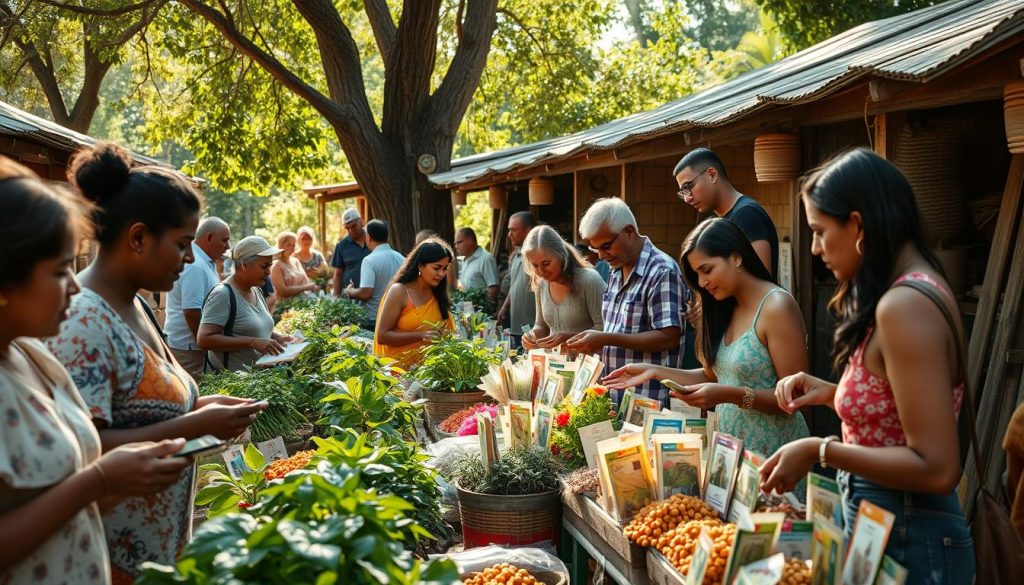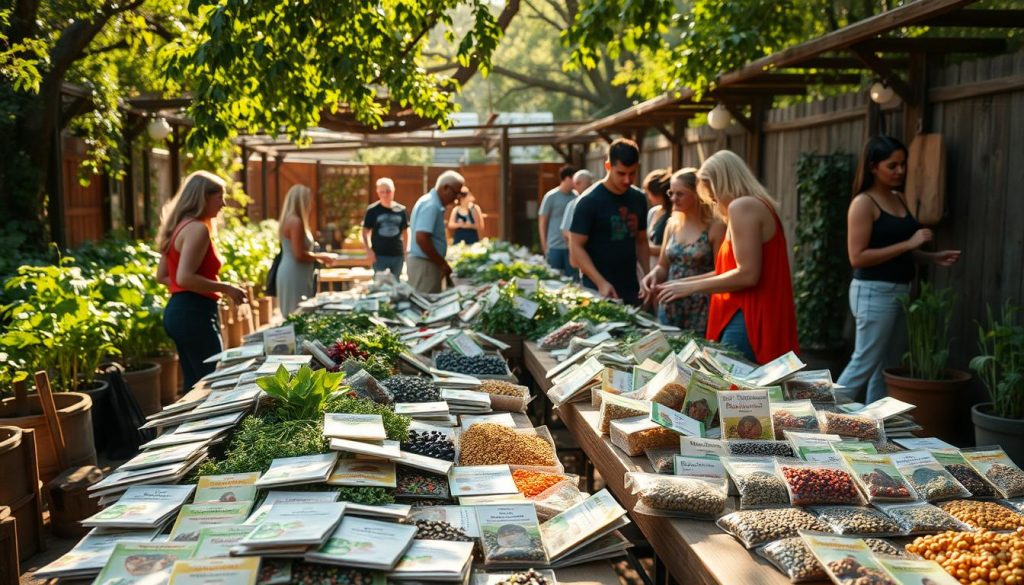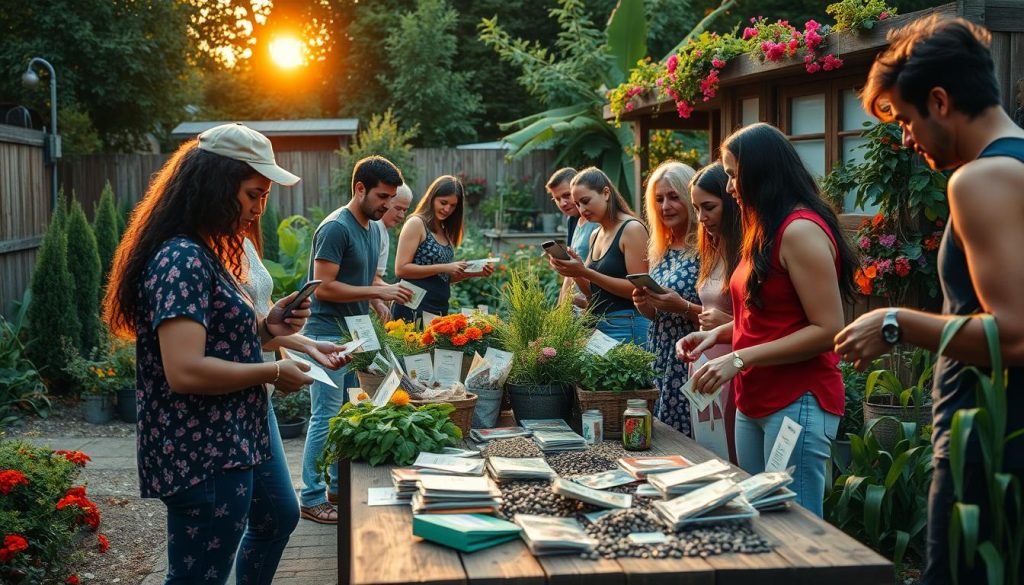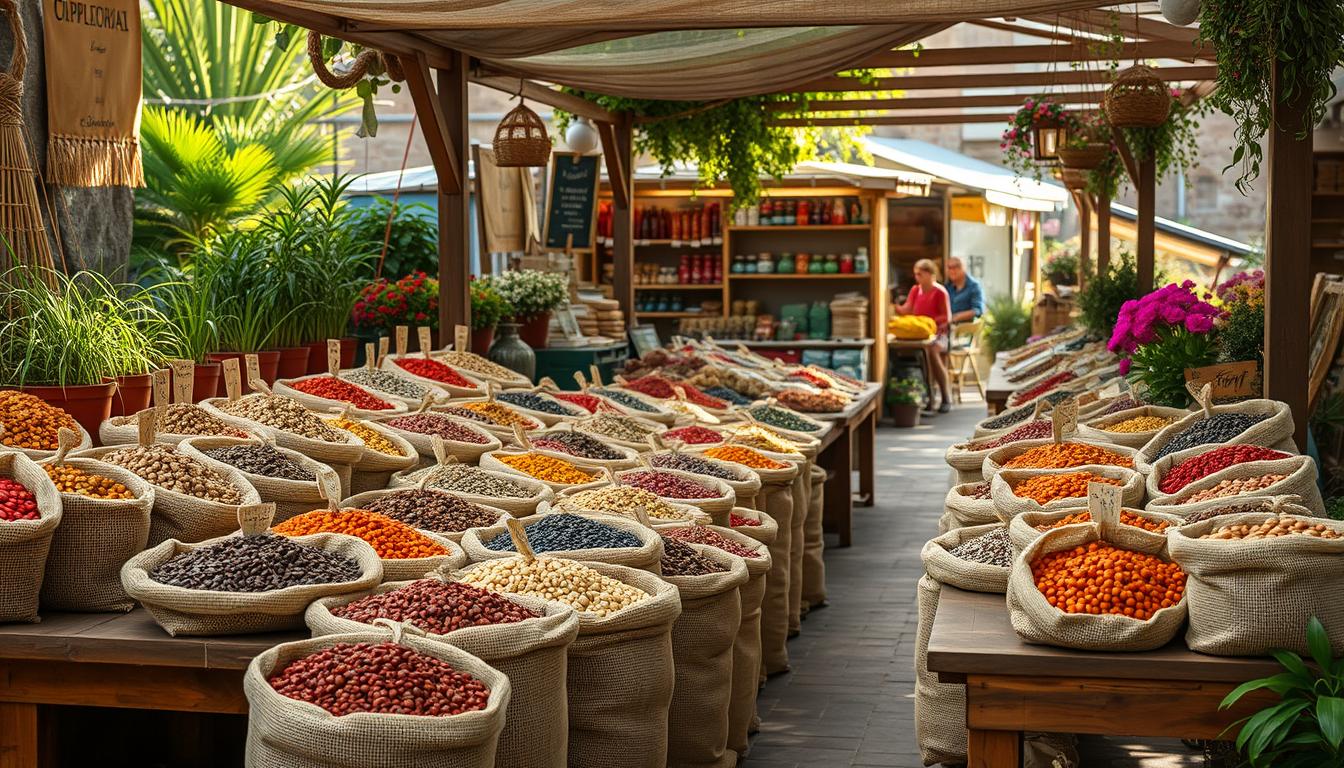I’m excited to share my journey in local seed trading. It’s a hobby that brings many benefits and challenges. I’m here to give you tips and insights on how to start trading seeds locally.
Trading seeds locally has connected me with other gardeners in my community. I’ll share my experiences. This will help you join community-based seed exchanges and start trading seeds with others.
Local seed trading is more than just exchanging seeds. It builds a sense of community and cooperation among gardeners. Whether you’re experienced or new, I hope to inspire you. I want to give you the knowledge and confidence to join a seed exchange program.
Understanding the Benefits of Local Seed Trading
Exploring local seed trading has shown me many benefits. It helps gardeners save heirloom seeds, increase biodiversity, and build community ties. Let’s dive into these advantages.
Local seed trading connects gardeners with others who love gardening. At seed swap events, people share seeds, tips, and stories. This community spirit is priceless, offering a chance to learn and grow together.
Why Support Local Seed Exchange?
Backing local seed exchanges is key for our gardens and the environment. It keeps plant diversity alive, crucial for their survival. It also uses seeds that fit our local climate and soil.
Creating Biodiversity in Your Garden
Trading seeds lets gardeners add variety to their spaces. This brings beauty and attracts more pollinators and insects. A diverse garden is healthier, fighting off pests and diseases better.

Connecting with Your Community
Local seed trading also strengthens community bonds. Through swaps and forums, we share knowledge and support. It builds a cooperative gardening community, vital for our success.
Getting Started with Seed Trading
To start trading seeds locally, you need to know the basics and get your seeds ready. When starting a seed trading group, think about the seeds you want to trade and their quality. This helps you find other gardeners in your area with similar interests.
It’s important to know what seeds you have. Start by labeling your seeds and keeping a list of your plants. This makes it easier to find traders looking for specific seeds. When trading, be clear about what you have and what you’re looking for.
Identifying Your Seed Varieties
- Label your seeds and keep a record of the types of plants you have
- Research the different types of seeds you have and their characteristics
- Consider the quality of the seeds and whether they are suitable for trading

How to Prepare Seeds for Trading
After identifying your seeds, prepare them for trading. Clean and dry the seeds, then package them for easy storage and transport. By following these steps, you can trade seeds with confidence and connect with other gardeners.
Finding Local Seed Networks
To succeed in local seed trading, it’s key to connect with other gardeners in your area. Join community gardening groups to meet people who share your interests. These groups often have seed exchange programs where you can trade seeds and share tips.
Online platforms are also great for finding local seed networks. They let gardeners connect, share seeds, and learn from each other. Look for social media groups and forums focused on local seed trading and gardening. This way, you can grow your network and find new trading opportunities.

Benefits of Local Seed Exchange
- Access to rare and unique seed varieties
- Opportunities to connect with experienced gardeners
- Support for local biodiversity and food security
Being part of a seed exchange program helps preserve local plant species and supports the local economy. It also lets you learn new gardening techniques and share your own. Whether you’re new to gardening or have lots of experience, joining local seed networks can be very rewarding.
The Seed Trading Process
Exploring local seed trading, I found that fair trade is key. It makes the experience both successful and fun. To trade seeds, knowing their value and being open about their quality and origin is important. Seed swap events are great for connecting, sharing knowledge, and trading seeds fairly.
Being part of a local seed trading network is very rewarding. It lets me meet other gardeners and learn from them. When trading seeds, it’s important to communicate well and be clear about what you want. Here are some tips:
- Research the seeds you’re interested in trading for to determine their value and rarity
- Be transparent about the quality and origin of the seeds you’re offering
- Start with small trades and gradually build up to more significant exchanges
By following these tips and joining a local seed trading network, you can have a great time. Whether you’re at seed swap events or trading online, being respectful, open, and fair is crucial.
Legal Considerations in Seed Trading
Exploring seed trading, I’ve learned about the legal side. It’s great to connect with local farmers and gardeners. But, we must understand state laws and plant protection rules.
Starting a seed trading group means knowing local laws. This includes seed labeling, packaging, and distribution rules. This way, we can trade seeds smoothly and help our local community.
- Research state regulations on seed trading and sales
- Understand plant protection laws and their implications on seed trading
- Ensure compliance with labeling and packaging requirements
- Establish clear communication channels with trading partners
Understanding seed trading laws lets us enjoy its benefits. We can connect with local farmers and support biodiversity. Always choose local seed trading and support local exchanges for a strong community.
Tips for Successful Seed Trading
To be a great seed trader, you need some key tips. Keeping seeds in good condition is very important. This makes them more appealing to others in the local seed trading network. Always store seeds in a cool, dry spot, away from sunlight.
Sharing growing tips with other traders is also key. It helps create a community in the seed exchange program. Plus, it’s a chance to learn from others and share your own knowledge. This way, you become a trusted and knowledgeable trader, building trust and credibility.
Best Practices for Seed Storage
- Store seeds in airtight containers to maintain humidity and prevent moisture from entering
- Keep seeds in a consistent temperature range, ideally between 40-50°F (4-10°C)
- Label and date each container to ensure easy identification and rotation of seeds
By following these tips, you can become a successful seed trader. You’ll help grow and diversify the seed exchange program. Always focus on proper seed storage and share your growing tips. This will help you build a strong reputation and a thriving seed trading experience.
Reflecting on My Seed Trading Experience
Looking back on my journey in
local seed trading
, I feel grateful and excited. The connections I’ve made with fellow gardeners are rewarding. We trade heirloom seeds and share growing tips.
This has not only grown my garden’s diversity. It has also taught me the value of saving local plant varieties.
The
benefits of seed trading
go beyond just seeds. It has deepened my understanding of sustainable gardening. It has also made me feel more connected to my community.
My goal is to keep participating in our
local seed trading
network. I want to share my knowledge and learn from others. Together, we can build a more resilient food system.
I urge all gardeners to try
local seed trading
. It offers joys and challenges. By supporting each other, we celebrate our local plant diversity. This creates a vibrant, connected community.

